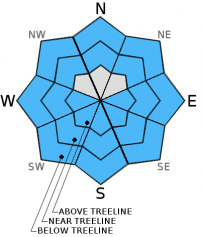| Saturday | Saturday Night | Sunday | |
|---|---|---|---|
| Weather: | Sunny | Partly cloudy | Partly cloudy becoming mostly cloudy |
| Temperatures: | 43 to 50 deg. F. | 26 to 31 deg. F. | 41 to 48 deg. F. |
| Mid Slope Winds: | East | Variable | Southwest |
| Wind Speed: | 10 to 15 mph with gusts to 25 mph becoming light in the afternoon | Light | 10 to 15 mph increasing to 20 to 25 mph with gusts to 40 mph in the afternoon |
| Expected snowfall: | 0 | 0 | 0 |
| Saturday | Saturday Night | Sunday | |
|---|---|---|---|
| Weather: | Sunny | Partly cloudy | Partly cloudy becoming mostly cloudy |
| Temperatures: | 39 to 44 deg. F. | 24 to 31 deg. F. | 35 to 42 deg. F. |
| Ridge Top Winds: | Southeast | West | Southwest |
| Wind Speed: | 15 to 20 mph with gusts to 30 mph in the morning | 10 to 15 mph with gusts to 25 mph after midnight | 15 to 20 mph with gusts to 30 mph increasing to 35 to 40 mph with gusts to 55 mph in the afternoon |
| Expected snowfall: | 0 | 0 | 0 |























